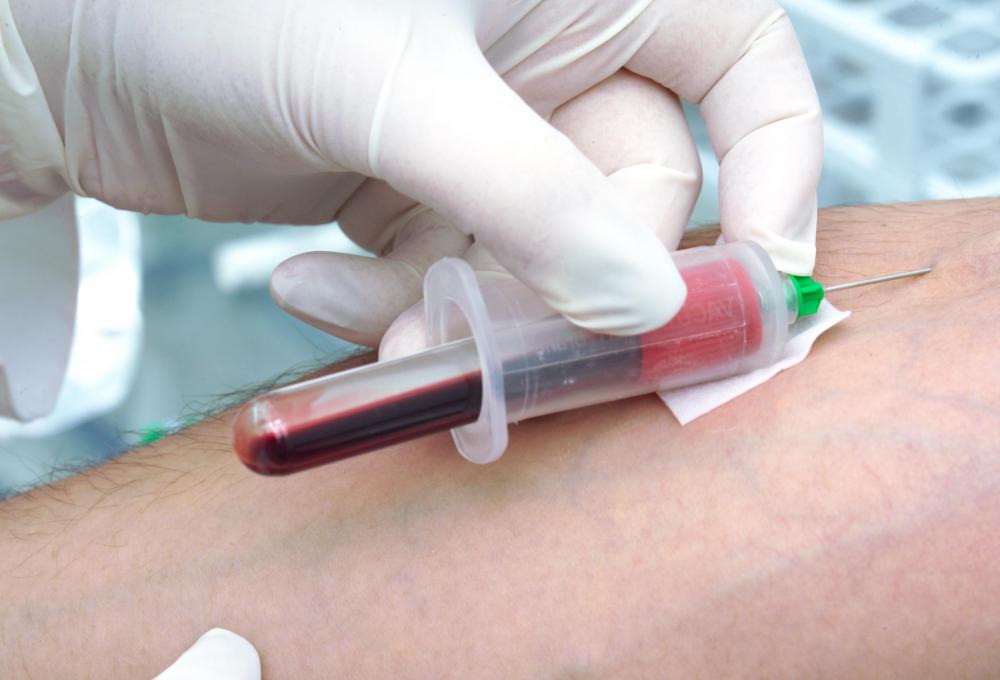At WiseGEEK, we're committed to delivering accurate, trustworthy information. Our expert-authored content is rigorously fact-checked and sourced from credible authorities. Discover how we uphold the highest standards in providing you with reliable knowledge.
What is Phlebotomy?
Phlebotomy is the act of drawing blood from a patient through the use of medical needles. The blood extracted through the needle is then studied by a physician in order to determine the patient's health condition. The blood may also be used in other patients in the form of a blood transfusion. A phlebotomist is a medical professional who draws blood from patients for these specific purposes.
Some people may need to receive regular phlebotomy. For example, people who have an overabundance of iron in the blood have a condition called hemochromatosis. These patients require the removal of blood on a regular basis. Those with a condition called polycythemia have bodies that produce too many red blood cells. Patients with this condition need to have frequent phlebotomy as well.

After a phlebotomist removes a small amount of blood from a patient's body, the patient may sometimes feel dizzy or tired. Some patients feel frightened when a phlebotomist must draw blood, and some cry. To help calm the fears of patients, phlebotomists must possess a calm, professional manner. They must be able to help patients feel more at ease as the blood is removed.

People who wish to become phlebotomists can attend local colleges or vocational schools in order to receive the necessary training. At times, employers will offer on-the-job training, but applicants with formal education this field are preferred. Typical courses include anatomy and physiology, lab safety, blood sampling procedures, and courses that teach how cells and the blood are affected by infection and disease.
Students will usually take a CPR course as well. They will receive hands-on training performing skin punctures and bloodletting through veins. Graduates of an accredited phlebotomy program earn a diploma or certificate.

Most U.S. employers require that phlebotomists are certified by American Medical Technologists (AMT), the American Society for Phlebotomy Technicians (ASPT), or the American Society for Clinical Pathology (ASCP). Each organization offers testing and national certification. Medical professionals who practice phlebotomy must renew certification on an annual basis. Once a phlebotomist begins working in the field, he or she will be responsible for a variety of tasks. Speaking with patients about procedures, taking blood from patients, updating medical records, sterilizing medical equipment, taking the patient's blood pressure, and sending blood and fecal samples to medical labs are all part of the job duties of a phlebotomist.
AS FEATURED ON:
AS FEATURED ON:













Discussion Comments
This makes me think of how they used to consider drawing blood to be the most important part of the doctor's job, because the science of the day thought that there was "good blood" and "bad blood" and that it was the bad blood that made you sick. I still don't understand how they thought they were telling the difference between the two different kinds of blood.
The interesting thing is that there actually was a benefit to that kind of blood letting. It even occasionally gets used today. It will bring down a fever and there are a few other benefits as well. Of course, it's only used at times when it's actually going to be a net benefit, since bleeding someone has so many drawbacks to take into consideration as well.
@chivebasil - I think the most economic way is to get hired into an phlebotomy technician in-training position and get educated on the job. I would call up the local blood testing center (or where ever nearby you know phlebotomists work) and ask them what they would recommend. Generally, if you are polite, they will be more than happy to explain what route they all took into the job.
What is the most economical way to get phlebotomy training? Are there specialized phlebotomy schools? I know that some people learn mostly on the job. I would like to break into this field because I recently got laid off and I need to find work that is steady. But I don't have a lot of money to invest on education.
If I take this course, where will I work because it is not that well known like other medical courses.
@snowywinter: In bigger cities with many hospitals and doctor’s offices, there are usually jobs available in the field of phlebotomy.
Yes, you can work at a doctor’s office or even a clinic. It is no longer necessary to have to go to the hospital just to get blood work done. Most physicians’ offices have a lab in them and you can get all of your blood work done there.
Dialysis clinics also hire phlebotomists. You can go to one of the employment websites and type in “phlebotomist jobs” and put in your zip code. They will show you all of the jobs available in the field of phlebotomy.
Are there usually phlebotomy jobs available? Do doctors' offices hire phlebotomist or can they just work at hospitals
Post your comments